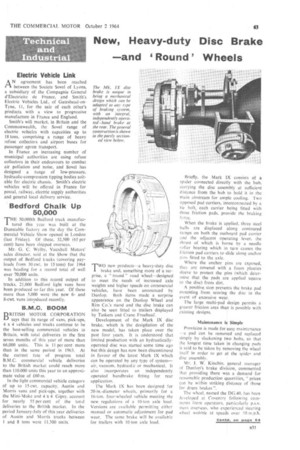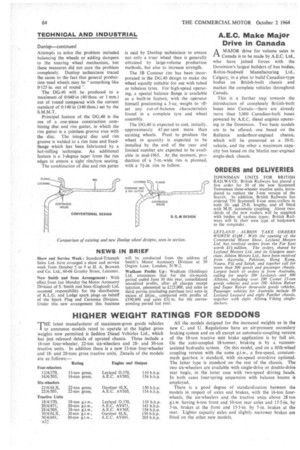New, Heavy-duty Disc Brake and 'Round' Wheels
Page 65

Page 66

If you've noticed an error in this article please click here to report it so we can fix it.
Electric Vehicle Link
AN agreement has been reached between the Societe Sovel of Lyons, a subsidiary of the Compagnie General d'Electricite de France. and Smith's Electric Vehicles Ltd., of Gateshead-onTyne, 11, for the sale of each other's products with a view to progressive manufacture in France and England.
Smith's will market, in Britain and the Commonwealth, the Sovel range of electric vehicles with capacities up to 18 tons, comprising a range of heavy refuse collectors and airport buses for passenger apron transport.
In France an increasing number of municipal authorities are using refuse collectors in their endeavours to combat air pollution and noise, and Sovel has designed a range of low-pressure, hydraulic-compression tipping bodies suitable for electric chassis. Smith's electric vehicles will be offered in France for postal, railway, electric supply authorities and general local delivery service.
Bedford Chalk Up 50,000
THE 50,000th Bedford truck manufac tured this year was built at the Dunstable factory on the day the Commercial Vehicle Show opened in London (last Friday). Of these, 32,500 (65 per cent) have been shipped overseas.
Mr.G. C. Welby, Vauxhall Motors' sales director, said at the Show that the output of Bedford trucks (covering payloads from 30 cwt. to 15 tons) for 1964 was heading for a record total of well over 70,000 units.
In addition to this record output of trucks, 21.000 Bedford light vans have been produced so far this year. Of these more than 5,000 were the new 6and 8-cwt. vans introduced recently.
B.M.C. BOOM
BRITISH MOTOR CORPORATION says that its range of vans, pick-ups, 4 x 4 'aides and trucks continue to he the best-selling commercial vehicles in Britain, with total deliveries in the first seven months of this year of more than 66,000 units. This is 11 per cent more than in the same period in 1963. At the current rate of progress total B.M.C. commercial vehicle deliveries to the British market could reach more than 110.000 units this year to an approximate value of £60 m.
In the light commercial vehicle category of up to 15 cwt. capacity, Austin and Morris vans and pick-ups, together with the Mini-Moke and 4 x 4 Gipsy. account for nearly 55 per cent of the total deliveries to the British market. In the period January-July of this year deliveries of Austin and Morris trucks between 1 and 8 tons were 11,300 units.
TWO new products—a heavy-duty disc brake and, something more of a surprise, a " round road wheel—designed to meet the needs of increased axle weights and higher speeds on commercial vehicles, have been announced by Dunlop. Both items made a surprise appearance on the Dunlop Wheel and Rim Co.'s stand and the disc brake can also be seen fitted to trailers displayed by Taskers and Crane Fruehauf.
Development of the Mark IX disc brake, which is the desigrtation of the new model, has taken place over the past four years. It is understood that limited production with an hydraulicallyoperated disc was started some time ago but this design has now been discontinued in favour of the latest Mark IX which can be operated by any type of system— air, vacuum, hydraulic or mechanical. It also incorporates an independently operated handbrake fitting for rear application.
The Mark IX has been designed for 20-in.-diameter wheels, primarily for a 16-ton, four-wheeled vehicle meeting the new regulations of a 10-ton axle load. Versions are available permitting either manual or automatic adjustment for pad wear. The same brake will be available for trailers with 10-ton axle load. Briefly, the Mark IX consists of a spider connected directly with the hub, carrying the disc assembly at sufficient distance from the hub to hold it in the main airstream for ample cooling. Two opposed pad carriers, interconnected by a tie bolt, each carrier being fitted with three friction pads. provide the braking force.
When the brake is applied, three steel balls are displaced along contoured ramps on both the outboard pad carrier and the adjacent operating lever, the thrust of which is borne by a needle roller hearing which in turn causes the friction pad carriers to slide along anchor pins fitted to the axle.
Where the anchor pins are exposed, they are covered with a foam plastics sleeve to protect the pins (which determine that the pads are applied square to the disc) from dirt.
A positive, stop prevents the brake pad mounting from scoring the disc in the event of excessive wear.
The large multi-pad design permits a greater friction area than is possible with existing designs.
Maintenance is Simple Provision is made for easy maintenance —a pad can be removed and replaced simply by slackening two bolts, so that the longest time taken in changing pads is said to he taken by removing the wheel itself in order to get at the spider and disc assembly.
Mr. J. W. Kinchin, general manager of Dunlop's brake division, commented that providing there was a demand for reasonable production quantities, "prices can he within striking distance of those for drum brakes
The wheel, named the DG.40. has been developed at Coventry following comments from operators. particularly p.s.v. users overseas, who experienced steering wheel vvohhle at speeds over 50 m.p.h. Attempts to solve the problem included balancing the wheels or adding dampers to the steering wheel mechanism, but these measures did not cure the problem completely. Dunlop technicians traced the cause to the fact that general production road wheels may be " something like 0-125 in. out of round ".
The DG.40 will . be produced to a maximum of 0-040 in (40 thou. or 1 mm.) out of round compared with the current standard of 0-140 in (140 thou.) set by the S. M.M ,T.
Principal feature of the DG.40 is the use of a one-piece construction combining disc and rim gutter, in which the rim gutter is a jointless groove true with the disc. The integral disc and rim groove is welded to a rim base and fixedflange which has been fabricated by a hot-rolling technique. An additional feature is a 3-degree taper from the rim edges to ensure a tight rim/tyre seating.
The combination of disc and rim gutter is said by Dunlop technicians to ensure not only a truer wheel than is generally obtained by large-volume production methods, but also to increase strength.
The 3B Contour rim has been incorporated in the DG.40 design to make the wheel equally suitable for use with tubed or tubeless tyres. For high-speed operating, a special balance flange is available as a built-in feature, with the operator himself positioning a 5-oz, weight to offset any cut-of-balance characteristics found in a complete tyre and wheel assembly.
The Da40 is expected to cost, initially, approximately 45 per cent more than existing wheels. Plant to produce the wheel in quantity is expected to be installed by the end of the year and limited number are expected to be available in mid-1965. At the moment, production of a 7-in.-wide rim is planned, with a 7+-in, rim to follow.
A.E.C. Make Major • Drive in Canada
A MAJOR drive for volume sales in
Canada is to be made by A.E.C. Ltd., who have joined forces with the Dominion's largest builders of bus bodies, Robin-Nodwell Manufacturing Ltd., Calgary, in a plan to build Canadian-type bodies on British-built chassis and market the complete vehicles throughout Canada.
This is a further step towards the introduction of completely British-built buses into Canada—there are already more than 3,000 Canadian-built buses powered by A.E.C. diesel engines operating in the Dominion. Two basic models are to be offered, one based on the Reliance underfloor-engined chassis, which will be presented as a 30-ft. vehicle, and the other a maximum capacity bus based on the Merlin rear-engined single-deck chassis.






























































































































































































































